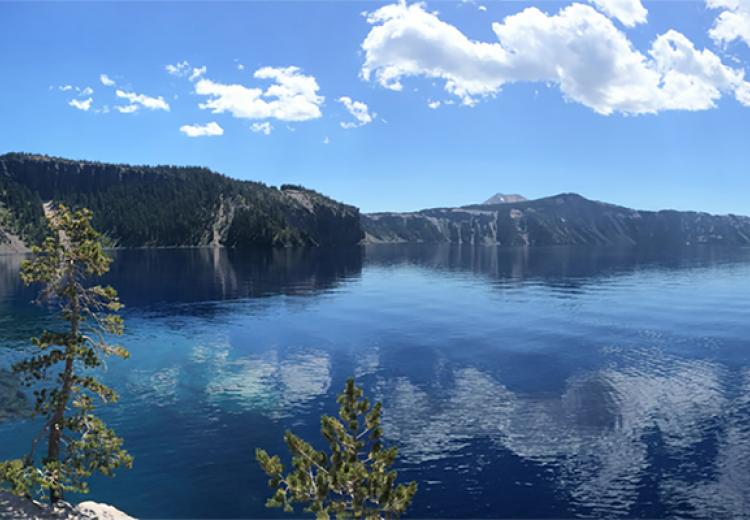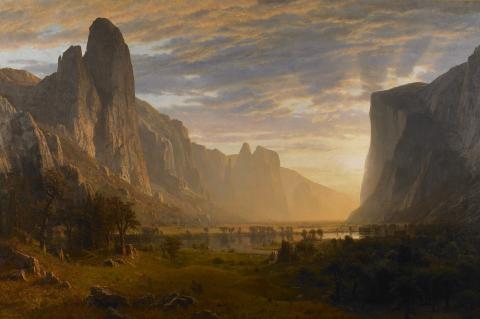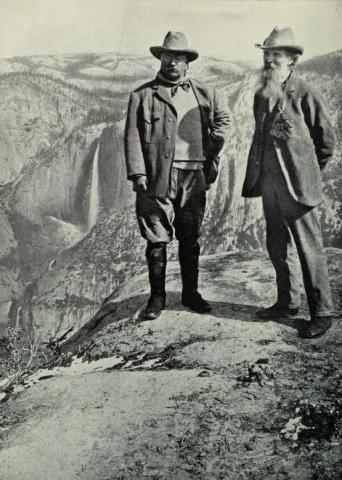The National Parks and History

Crater Lake National Park, Oregon.
Source: author photograph
Nicholas Di Taranto is a Program Analyst in the Division of Education Programs at the National Endowment for the Humanities.
It was, and remains, the bluest blue I have ever seen. As I stood on a rock jutting out over Crater Lake, the remnants of a massive volcanic eruption 7,700 years ago, I thought about the immensity of time and history that gives this place shape and meaning. Then I leapt. The freezing cold water disrupted these thoughts for the moment, but the National Parks have a way of sticking with you.
The National Parks encompass more than their physical components: mountains, rivers, canyons, forests. They also encompass history: stories, ideas, and values. The National Parks and their meaning have evolved with changing natural, social, and cultural contexts, making their story a useful lens for teaching and studying history.
The idea of establishing a National Park system—something writer and historian Wallace Stegner called “America’s best idea”—can be traced back to a number of distinctively American concepts, mid 19th-century movements and politics, as well as the technological and demographic change.
Bierstadt’s painting, Looking Down Yosemite Valley, (above) emphasized sublime scenery, seemingly touched by god, where Americans could wash their spirit clean; a place uniquely American. Use this painting in the classroom with this lesson plan from Picturing America.
Establishing National Parks
The idea of the National Parks sprung from the literature, arts, politics, and demographic and technological change of the United States as the country turned one hundred years old. In the mid-19th century, artistic movements like Transcendentalism and Romanticism promised sublime experiences and a cleansing of the soul through nature, which many Americans found appealing. Moreover, these humanistic expressions provided philosophical underpinnings of the applied science of the conservation movement, which had a growing influence on environmental and resource management beginning in the second half of the 19th century. Many Americans also believed it was the nation’s Manifest Destiny to expand west, even if it came at someone else’s expense. Native Americans who had long lived on and used much of the land in and around what would become National Parks, imbuing the land with indigenous stories and values, were often dispossessed or had restrictions placed on their use. With passage of Yellowstone National Park Protection, the land became enmeshed in United States history.
In March 1872, Congress established Yellowstone National Park, the first in the world. Yosemite, Sequoia, and Mount Rainer soon joined Yellowstone. At the time, though, the parks were not easily accessible, and an increasing number of Americans lived in cities. The development of the Transcontinental Railroads made the parks more accessible, but also threatened them with commercialization and development.
Railroads were important early boosters of National Parks, luring tourists with the promise of spectacular scenery of “civilized” wilderness paired with fine dining and upscale lodging. Efforts to “civilize” nature intertwined with efforts to control human behavior in the 19th century, creating an ever-evolving debate over who and what are allowed on the land. An emerging legal framework began restricting traditional practices of Native Americans and rural Americans, such as hunting, fishing, and foraging, even as it allowed increased tourism and development. By the 20th century, debates over land use had reached the highest levels of the government.
“The movement for the conservation of wild life and the larger movement for the conservation of all our natural resources are essentially democratic in spirit, purpose, and method.”
—President Theodore Roosevelt
Creation of the National Parks Service
Conservation became a cornerstone of Theodore Roosevelt’s administration. By the end of his presidency, Roosevelt had created five new national parks, 51 federal bird sanctuaries, four national game refuges, 18 national monuments, and more than 100 million acres’ worth of national forests, yet, in all practicality, this land remained largely unprotected. At the time, there still lacked a single authority to manage and protect the areas set aside for preservation, which left them vulnerable to development. The damming of the Tuolumne River in Yosemite’s Hetch Hetchy Valley to provide water for a burgeoning San Francisco—over an opposition led by John Muir—became a rallying cry for greater protections. On August 25, 1916, President Woodrow Wilson signed the Organic Act of 1916, creating the National Park Service and tasked the new bureau with managing the United States’ existing and future National Parks.
The Parks Today
To this day, the National Parks throughout the nation remain a popular tourist destination, though most people now arrive in cars via the Interstate Highway System rather than by railroad. Evolving ideas about the human relationship to the environment, especially after World War II, has led to a more diversified National Park System that encompasses over four hundred units, large and small, preserving history, culture and natural splendor in urban and rural areas across the United States.


